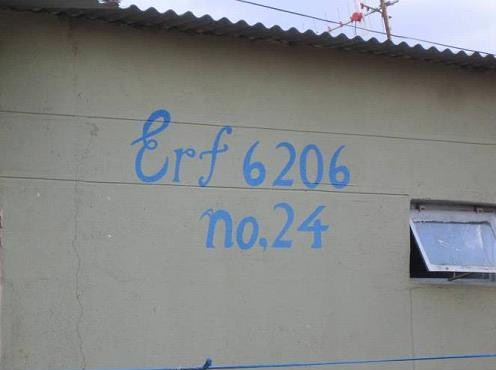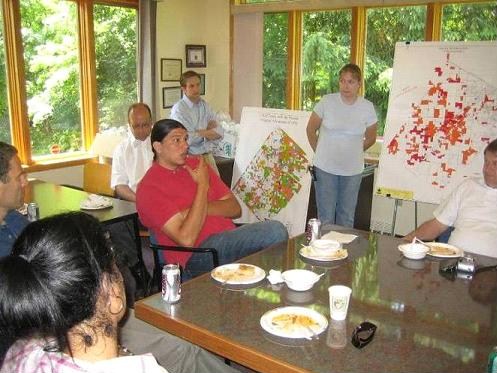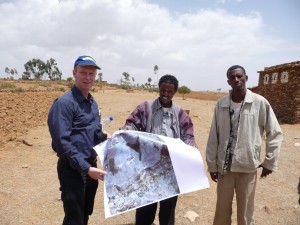| Perspective | |
Cadastres, Nations and States
The work of land surveyors and land registrars can be seen in a context of state and nation building |
|
 |
|
|||||
In the book ‘Congo’ (2010), the author David van Reijbrouck reports about the roundtable conference in Brussels in January 1960. There, the Belgian and Congolese delegation agreed on independence of the Congo already in June of that year. From an institutional side, hardly anything was in place in the -soon ‘former’- colony. Executive staff was panicking: ‘how to get a popular census in place in six months, a number plate administration, a cadastre…’.
This is a nice illustration that –somehow- cadastres have to do with the building of a nation.
As we know that cadastral systems world wide show a great difference (although they also share features), it is worthwhile to have a closer look to the relation between cadastres and nation-building.
‘Cadastres’, or broader ‘a land administration system’ is defined by the UN Land Administration Guidelines, 1996/2005 as ‘the process of determining, recording and disseminating information about ownership, use and value of land, when implementing land management policies’.
Nation Building
What is Nation building? Here we enter a very sensitive domain. Politicians easily mix up Nation and State; see for example the ‘United Nations’, or ‘nationalism’, which are always associated with the ‘state’ as the main focus of an individual’s loyalty…
‘Oneida Nation’, tribe of Indians (US)
Its is sensitive, because scholarly publications make clear that ethnic diversity, ethnic consciousness and ethnic loyalty, easily lead to a situation where people tend to be loyal to one’s own ethnic group, and not necessarily to a State.
Therefore, the literature makes clear distinction between Nation and State, as follows: a ‘Nation is a social group sharing common ideology, institutions, language and homogeneity’, while a ‘State is a legal concept describing a social group that occupies a certain territory and is organised under common political institutions and an effective government’.
To say it more easily: a Nation is a tight knit group with common culture, and a State is self governing entity
Nation and State
By consequence, the boundaries of Nations do not necessarily coincidence with the boundaries of a State. Statistics show that about 50% of the countries in the world have a situation where States include various Nations or where Nations cover various States. Examples of the latter are the Kurd nation in the Middle East, the Hungarian nation in central Europe, or the Ashanti Kingdom in Africa. Examples of the first are many, actually every country that host various ethnic Nations, such as the Han, Mongols, Uyghur’s or Tibetans in China, or closer to home, the Flamands and Walloons in Belgium.
When we speak about Africa, we can find many examples, finding their origin in the Berlin Conference of 1884, where the scramble for Africa was formalised. However, also countries without a colonial history such as Ethiopia or Thailand had to face this situation, with respectively the Eritreans and the Lao people.
Today, about 60 conflicts take place between Nations and the State, often based on separist movements however in any case based on ethnic consciousness, such as Sri Lanka (Tamils), India (Punjab, Kashmir), Kirgizstan (Uzbeks), Sudan (Darfur), Kenya (Kikuyu, Lua tribe), Turkey (Kurds), Kosovo (Albanians en Serbs), and who can ever forget the fight between Hutu’s and Tutsi’s in Rwanda, leading to the genocide of 1994.
Land Administration
The distinction between Nation and State is a very useful distinction also for land administrators, because we know that the common culture of Nations often include a specific understanding of what property rights are. Referring to the definition of a land administration system, especially where it speaks about the determination of land rights, this different understanding of property cannot be without impact on how we think about land registration and cadastre.
Actually, I see three different situations exist.
The first is the relatively simple case of the Nation-State, where the common culture of a Nation equals loyalty to a State government.
The second case is the State that comprises various Nations and which has the challenge to build a State-edifice where an individuals’ loyalty to the Nation can exist alongside the loyalty to the State.
The third case is the fragile and post-conflict State, where reconciliation should develop between groups that were formerly in conflict with each other.
Nation States
In the first case, the Nation States (which are to a certain extent quite homogeneous), the question is under which kind of State the society should further develop. Here we enter the domain of political economics, namely what is the nature of the intervention of the State in society. This is called ‘State building’, namely the construction of the foundation of the government edifice, within which governance ought to operate. Without prior construction of this edifice, governance interventions are likely to have only limited effects. It differs whether a society opts for a welfare or neo-liberal approach. In the first case, it is believed that free market forces are in major societal fields unable to deliver socially optimal outcomes. The policy advises of the World Bank and the International Monetary Funds take another stance, namely that it is the free market that will bring progress and prosperity (‘Washington Consensus’). In the neoliberal State, rules are considered as rigidities which prevent the smooth operation of market forces. Political evaluations have shown that such neo-liberal policy advises often resulted in economic catastrophes, such as in Ghana, Kenya, Zimbabwe, and many countries in Latin America.
Another approach, ‘institutional economics’, considers the role of the State as an entrepreneur, providing for a vision for society, and creating the institutions required to achieve that vision. Why? Because basically the State is the only ‘agent’ (as it is called in sociology) which may represent the society as a whole.
The State has to coordinate, which -by the way- brought earlier Karl Marx to the opinion that this State coordination would bring expansion of the State interventions, leading ultimately to central planning under socialism.
‘Institutional economics’ is the domain of scholars like Douglas North (who got a Nobel price in 1993) and Oliver Williamson (who got it in 2009).

‘Real life’ parcel numbering in Namibia
Modern urban cadastre Moscow
Why these remarks about State intervention? Especially in the approach of Douglas North, I see a clear connection with land administration systems. North defines institutions as ‘the humanly devised constraints that shape human interactions’. Without these ‘rules of the game’ (whether the rules are based on the law or on social norms and values) we -as human beings- cannot deal with each other. In his elaboration of what institutions are, North distinguishes three elements, namely market exchange should be complete (which means should include externalities), the transaction costs of market exchange should be a low as possible, and -where there is a risk of market failure- the market should not coordinate but the government, in the form of organisations.
So, a sound definition of property rights and their registration in a land administration system definitely belongs to the necessary institutions to build a State, as is shown in the publications of the chief researcher of the World Bank, dr. Gershon Feder and in the dissertation The Human Right to Property of the late dr. Theo van Banning, the Dutch representative to the FAO in Rome.
State and various Nations
When it comes to the second case, namely those States that comprise a various amount of Nations (ethnic groups), there the situation is more complex, as various property regimes might exist in one and the same country, property regimes that include different rights to land, different ways of transferring such property right, different ways of inheritance, different role of men and women when it comes to holding land rights. The introduction of the Basic Agrarian Law in 1960 in Indonesia provided for inclusion of ‘adat’ rights, in practice however it seems to be impossible as almost every kampong has it own property arrangement. Papua New Guinea hosts more than 1000 ethnic groups, each of them with own understanding of property rights.
Public kiosk urban cadastre Xi’An (China)
Cadastral Archives in Accra
Innovative cadastral data aquisition Ethiopia
The main challenge for the States comprising various Nations, is to accept loyalty to Nations alongside loyalty to the State, in stead of imposing central power and policy. This choice is described as either Nation-building, or Nation-destroying. When it comes to property rights, we can read in the book ‘The State of Africa’ of Martin Meredith (2005), that there are many examples of the latter, imposing land rights regimes, such as Kenya, where -after independence in 1963- the Kenyatta administration adopted the colonial freehold and leasehold as the only permitted form of land tenure, neglecting the variety of tenure forms that were practised by local communities, or the collectivization of community property during the Ujamaa policy of Julius Neyere in Tanzania in the seventies.
The land tenure regimes of local tribes are often substantially different from the western notion of private property, in the sense that in large parts of Africa the concept of common property is practised. Tribes, families, villages hold their lands in common, ruled by the chief, family head, or village elderly.
The publication The Tragedy of the Commons, in 1968 in the authoritative journal Science by Garret Hardin, however, suggested that common property regimes might result in over-exploitation of land with negative outcomes for environmental preservation. This view, created the fundament for the first land reform policy paper in 1974 of the World Bank, encouraging abolishment of common property in favour of private property. Until recently, this approach to land tenure, has driven the policy advises of the Bank to developing countries, and by consequence the enforcement of many land titling programmes all over the world.
The discourse between common and private property was subject to political debate in Europe already in 1840, when Pierre Joseph Proudhon published his famous book on ‘What is property’, leading to the slogan ‘property is theft!’, or ‘property is robbery’, later adopted by the young Karl Marx and Friedrich Engels in the first point of the programme of the Communist Manifesto in 1848, namely the ‘abolition of private property in land and application of all rents of land to public purposes’.
Project evaluations demonstrate that many titling project brought disaster for local communities, and failed in delivering the benefits assumed to be associated with individual private property rights. This was clearly described by World Bank researchers John Bruce and Sam Migot-Adholla, in their seminal book ‘In search for land tenure security in Africa’, in 1993, where they provided evidence that common lands were well managed, according to traditional environmental understanding, which had proven to be valid during decennia, and that -at the contrary- private property resulted in over exploitation, because of private owners sub-optimizing their own benefit, despite occurrence of negative externalities. This book effected on the understanding of the value of customary land tenure and land management practices is such a way, that after extensive consultation by the World Bank, a policy research report in 2003 by the Bank, ‘Land Policy for Growth and Poverty Reduction’ (K. Deininger) embarked on more recognition of customary land tenure arrangements and land management practices, to provide for land tenure security and socially desirable land use.
The matter became very serious, when Eddie Mabo, an aboriginal, on 3 June 1992 won a dispute before the Supreme Court of Australia with the state of Queensland, about recognition of his tribe’s rights to land which existed before the British vested their own land rights in what they considered as terra nullius. Since then, land rights of indigenous peoples everywhere were recognised, not only the so called ‘native titles’ in Australia, but for example ‘Maori titles’ in New Zealand, and ‘native titles’’ for Indians and Inuit in the US en Canada respectively.
In anthropology such situation is indicated as ‘legal pluralism’, which means that people might have various jurisdictions in their head.
To cope with various land tenure regimes in land administration system design, the pioneering work of Christiaan Lemmen and Peter van Oosterom on the ‘Land Administration Domain Model’ should be mentioned, because the model they developed aims at accommodating all kinds of land rights in a standardised and therefore manageable way. This is luckily recognised by the big players in the land administration world, because the domain model is currently adopted by UN/Habitat, while World Bank, FAO en the US based MCC are on track in adopting the model. The Model is on its way to become a ISO international standard.
State and Nations in Conflict
When it comes to the third case, the fragile and post conflict States, we still are not sure how to tackle the property rights issue. These –about 40- States cannot yet exercise the core functions of governance, as there are the monopoly of violence, revenue generating, enforcing the rule of law, and the delivery of basic services. They lack weak institutions and a fundamental lack of capacity. In many peace agreements and interim government policy plans however, the establishment of property rights and appropriate registration got priority, such as UNMIK policy plan in Kosovo in 2002, the 1996 Treaty for Peace in Guatemala, the 1991 Peace Treaty in Cambodia, the 2002 National Development Framework of the -then- intern government of Afghanistan, the 1992 peace accord for El Salvador and the Arusha Peace Treaty in Rwanda in 1993.
But how to do? From theory we know that the desirable sequence is first to create constitutive capacity, which can be followed by the development of public administration leading to the rule of law and security. The UN Habitat promotes in the Handbook for Post Conflict Land Administration and Peace Building (2007) that land records as exist prior to a conflict should be protected as much as possible, to have at least some historical material when it would come to rebuilding a cadastre, and not -as happened in Kosovo- where the Serbs took all land registers and cadastral maps from Pristine to Belgrade, where they still are today, leaving a country without an opportunity to reconstruct land rights based on historical evidence. Their plea is that military intervention forces immediately should protect cadastre offices in order to avoid any deletion or theft.
One thing is very clear: when the land registrar writes a name of an owner in the land book, and the land surveyor draws a line on a cadastral map indicating a boundary, and both are not accepted as fair by the population, the country might enter into a second conflict, which for example is said to be a risk for Guatemala.
Epilogue
The paper shows that the work of land surveyors and land registrars can be seen in a context of state and nation building. A cadastre is an institution that contributes to the government edifice, in which governance can take place. Whether this ‘governance’ can meet the international supported norms of what ‘good governance’ is, also depends on whether land professionals can associate with wider concepts. When they understand the concepts of State and Nation they can design land administration systems that meet the token of time.
My Coordinates |
EDITORIAL |
|
Mark your calendar |
MAY 2011 TO AUGUST 2011 |
|
News |
INDUSTRY | LBS | GPS | GIS | REMOTE SENSING | GALILEO UPDATE |

















 (52 votes, average: 1.19 out of 5)
(52 votes, average: 1.19 out of 5)





Leave your response!